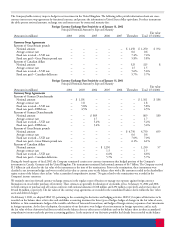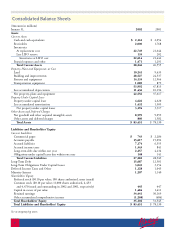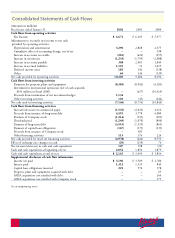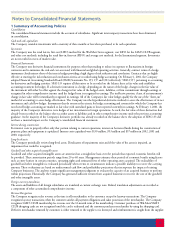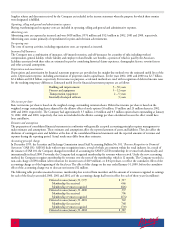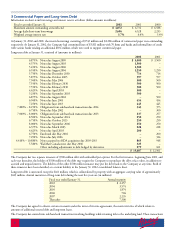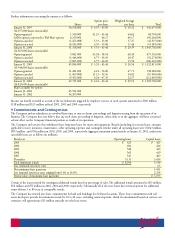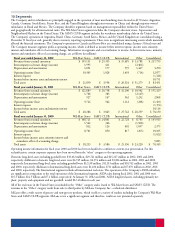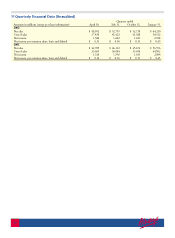Walmart 2002 Annual Report Download - page 32
Download and view the complete annual report
Please find page 32 of the 2002 Walmart annual report below. You can navigate through the pages in the report by either clicking on the pages listed below, or by using the keyword search tool below to find specific information within the annual report.
30
The Company’s deferred revenue is included in accrued liabilities in the consolidated balance sheet. The Company’s analysis of
historical membership fee refunds indicates that refunds have been minimal. Accordingly, no reserve exists for membership fee refunds
at January 31, 2002.
An additional requirement of SAB 101 is that layaway transactions be recognized upon delivery of the merchandise to the customer rather
than at the time that the merchandise is placed on layaway. The Company offers a layaway program that allows customers to make payments
on items over a specific period. Until the first quarter of fiscal 2001, the Company recognized revenues from these layaway transactions at the
time that the merchandise was placed on layaway. During the first quarter of fiscal 2001, the Company changed its accounting method for
layaway transactions so that the revenue from these transactions is not recognized until the customer satisfies all payment obligations and
takes possession of the merchandise. Layaway transactions are a small portion of the Company’s revenue. Due to the minimal impact of this
accounting change, prior fiscal year results have not been restated.
New accounting pronouncements
In June 2001, the Financial Accounting Standards Board issued Statements of Financial Accounting Standards No. 141, Business
Combinations, and No. 142, Goodwill and Other Intangible Assets, effective for fiscal years beginning after December 15, 2001. Under the new
rules, goodwill and intangible assets deemed to have indefinite lives will no longer be amortized, but will be subject to annual impairment
tests in accordance with the Statements. Other intangible assets will continue to be amortized over their useful lives.
The Company will apply the new rules on accounting for goodwill and other intangible assets beginning in the first quarter of fiscal 2003.
Application of the nonamortization provisions of the Statement is expected to result in an increase in net income of approximately
$250 million for fiscal 2003. Prior to the completion of the second quarter of fiscal 2003, the Company will complete a transitional
impairment review for goodwill and indefinite lived intangible assets as of the date of adoption. Subsequently, the Company will perform
similar impairment reviews annually. Management does not believe that the adoption of the impairment review provisions of the standard
will have a material effect on the Company’s financial position or results of operations.
In August 2001, the Financial Accounting Standards Board issued Statement of Financial Accounting Standards No. 144, Accounting for
the Impairment or Disposal of Long-Lived Assets (FAS 144), which addresses financial accounting and reporting for the impairment or disposal
of long-lived assets. FAS 144 supersedes SFAS No. 121, Accounting for the Impairment of Long-Lived Assets and for Long-Lived Assets to be
Disposed Of, and the accounting and reporting provisions of APB Opinion No. 30, Reporting the Results of Operations for a Disposal of a
Segment of a Business. The Company will adopt FAS 144 as of February 1, 2002 and does not believe that the adoption of FAS 144 will have
a material impact on the Company’s financial position or results of operations.
In May 2000, the Emerging Issues Task Force (EITF) reached a consensus on Issue 00-14, Accounting for Certain Sales Incentives. This issue
involves the accounting and income statement classification for sales subject to rebates and revenue sharing arrangements as well as coupons
and discounts. The EITF concluded that sales incentives offered to customers to buy a product should be classified as a reduction of sales.
The Company will implement Issue 00-14 in the first quarter of fiscal 2003. The Company does not expect any reclassification because of its
Every Day Low Price strategy and because rebates and coupons accepted by the Company’s stores are offered by the product’s supplier and
not by the Company. As a result, the adoption of this guidance is not expected to have a significant impact on the Company’s financial
position or results of operations.
Reclassifications
Certain reclassifications have been made to prior periods to conform to current presentations.
2 Defined Contribution Plans
In the United States, the Company maintains a Profit Sharing Plan under which most full-time and many part-time Associates become
participants following one year of employment and 401(k) retirement savings plans to which Associates may elect to contribute a percentage
of their earnings. During fiscal 2002 most participants could contribute up to 15% of their pretax earnings, but not more than statutory
limits.
The Company made annual contributions in cash to these plans on behalf of all eligible Associates, including those who did not elect to
contribute to the 401(k) plan. During fiscal 2002, eligible Associates could choose to receive a cash payout equal to one-half of the Company
contribution that otherwise would have been made into the 401(k) plan. Those who did not choose a cash option had their money
contributed into their 401(k) plan. Associates may choose from among 14 different 401(k) investment options. For Associates who do not
make any election, their 401(k) balance is placed in a conservative balanced fund. Associates are immediately vested in their 401(k) funds
and may change their investment options at any time.
Additionally, the Company maintains various plans internationally. These plans are administered based upon the legislative and tax
requirements in the country in which they are established.
Annual contributions to the 401(k) and profit sharing plans and the various international plans are made at the sole discretion of the
Company, and were $555 million, $486 million and $429 million in 2002, 2001 and 2000, respectively. In addition, in fiscal 2002 the
Company paid $34 million in cash to Associates in lieu of Company contributions to the 401(k) plan.




